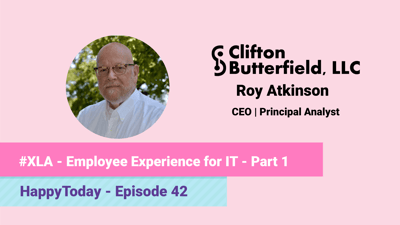Experience Management Acronyms Explained
This blog shares definitions for 20 of the most commonly used experience-related acronyms.

This article can also be downloaded as a PDF.
Some might view experience management as the latest IT service management (ITSM) trend. However, our customers demonstrate that it makes a real difference – playing an essential role in ensuring that IT services and support capabilities meet both business and end-user needs. The insight that experience data brings allows them to identify issues and improve both productivity and outcomes.
We’ve already created experience-management guidance to help customers and anyone else looking to get started – for example, the IT Experience Management (ITXM) Framework and the ITXM Academy. But we also appreciate that, like many areas of IT, experience management is awash with acronyms (with some of them having more than three letters too).
To help, this blog shares definitions for 20 of the most commonly used experience-related acronyms.
20 experience management acronyms explained
- CES: customer effort score – this metric calculates an external customer’s effort to get help. While usually an externally-facing customer experience surveying method, it can be used for internal support too.
- CSAT: customer satisfaction – this metric isn’t really experience-related, but some organizations will see it as a proxy for experience measurement and, as such, it’ll likely be used when talking about employee or end-user experiences with IT. CSAT is commonly used in the context of CSAT questionnaires automatically sent to end-users, via the ITSM tool, either after an IT service desk engagement or periodically about more general experiences with IT.
- CSF: critical success factor – this is usually one of multiple factors or endstates necessary for success. CSFs can relate to the success of organizations, teams, processes, services, or projects.
- CX: customer experience – the practice of CX is usually employed in the context of external customers. It is commonly defined as “the sum total of customers’ perceptions and feelings resulting from interactions with a brand’s products and services.” However, some organizations and support-focused membership bodies, such as SDI and HDI, use “customer” to describe employees. Hence, they might use CX instead of EX (see below) when talking about the experiences of employees or end-users. Although ITIL service management best practice guidance has traditionally precluded employees being called “customers,” with this definition reserved for the corporate roles responsible for paying for services. More recently, ITIL 4 has defined a customer as “a person who defines the requirements for a service and takes responsibility for the outcomes of service consumption.”
- DEX: digital employee experience – this term describes the focus on employee experiences with technology that has evolved from endpoint management. It uses technologies to measure how IT services and devices are performing for employees. This insight can be supplemented with end-user feedback (called “end-user sentiment”). DEX management has replaced DEM (digital experience management or monitoring) as the commonly used term for the technology-based assessment of employee experience.
- DXP: digital experience platform – this is defined in the online Gartner Glossary as “…an integrated set of core technologies that support the composition, management, delivery and optimization of contextualized digital experiences.”
- EOS: employee opinion survey (or employee survey) – this is a method for gaining feedback from employees on various areas such as line-manager performance, employee engagement, and employee morale.
- EPM: endpoint monitoring or management – this is the use of technologies that provide visibility into end-user devices, with capabilities that include detection, deployment, updating (e.g. security patches), and troubleshooting the endpoint devices. The EPM acronym might also be used for endpoint policy management or endpoint privilege management.
- EU: end-user – this is an IT term used to describe the people that use technology. These people might be employees or customers. Or, in the case of managed service providers (MSPs), end-users include the employees of customer organizations.
- EX: employee experience – the online Gartner Glossary defines EX, in Human Resources (HR) terms, as “the way in which employees internalize and interpret the interactions they have with their organization, as well as the context that underlies those interactions.” However, a Forrester Research quote might be deemed to provide greater insight for IT, that “…the most important factor for employee experience is being able to make progress every day toward the work that they believe is most important.”
- FCR: first call resolution or first contact resolution – this metric focuses on the proportion of end-user calls or contacts resolved in the first engagement. While it’s a flawed IT metric in experience terms, it does offer insight into the level of call “bouncing” between resolution groups and IT personnel.
- ITXM™: IT experience management – this is bringing experience management principles into IT operations to allow IT teams to focus on the outcomes of the work they do and provide data-driven insights that fuel the continual improvement needed to improve these outcomes. This improvement includes making end-users happier with IT services and support and more productive in their daily work.
- KPI: key performance indicator – this is a measure that helps organizations to evaluate success. KPIs support CSFs.
- NPS: net promoter score – this is a measurement of the delivered CX that employs a critical question, a scoring method (0-10), and respondent groups (promoters (scoring 9-10), passives (scoring 7-8), and detractors (scoring 0-6)). It’s calculated by subtracting the percentage of detractors from the promotors. This method can also be applied to EX, as with the HappySignals Happiness Score.
- RUM: real user monitoring – these are DEX technologies that measure end-user experience from the employee’s perspective (for example, at a web application level).
- SLA: service level agreement – ITIL service management best practice guidance defines an SLA as “A documented agreement between a service provider and a customer that identifies both services required and the expected level of service.”
- UX: user experience – this is an area of design focused on ensuring that technology is intuitive and user-friendly. UX influences the overall CX or EX, but it isn’t the same.
- WFH or WFA: working from home or working from anywhere – these terms describe corporate policies for non-office-based working. WFH is when employees are set up to work in an office at their home. WFA, also called “hybrid” working, is when employees work in an office (or offices) and other locations, including at home. Both WFH and WFA employees are also called “remote workers."
- VoC: voice of the customer – this is a method for collecting and acting on customer feedback related to their experiences with, and expectations of, a company and its products or services. It can also be applied internally for employees.
- XLA: experience level agreement – XLAs are a reimagining of SLAs that focus on what’s most important to the end-user. They measure the performance of IT by quantifying the end-user experience and IT service outcomes. Ultimately, XLAs measure performance in outcome and value terms, whereas SLAs usually focus on operations and outputs.
The IT industry will likely create new experience management acronyms as adoption increases, but, hopefully, the above list is a good starting point.
Related content

05.11.2024
Driving Transformative IT and GBS Experiences at PepsiCo
An Interview with Prashant Arora: Driving Transformative IT and Global Business Service Experiences at PepsiCo
Read more >

